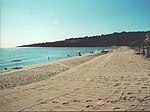Chiesa Madre, Carlentini
18th-century Roman Catholic church buildings in ItalyChurches in the province of Syracuse

Chiesa Madre or "Mother Church" of Carlentini is a baroque-style, Roman Catholic church located on via Via Roma #140, corner with via Garibaldi, in center of the town of Carlentini in the province of Syracuse, region of Sicily, Italy. The church is dedicated to the Immaculate Conception (Immacolata Concezione in Italian).
Excerpt from the Wikipedia article Chiesa Madre, Carlentini (License: CC BY-SA 3.0, Authors, Images).Chiesa Madre, Carlentini
Via Roma,
Geographical coordinates (GPS) Address Nearby Places Show on map
Geographical coordinates (GPS)
| Latitude | Longitude |
|---|---|
| N 37.27507 ° | E 15.01463 ° |
Address
Via Roma 42
96013
Sicily, Italy
Open on Google Maps










